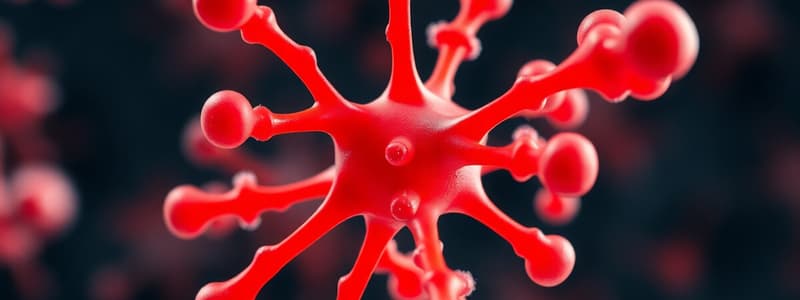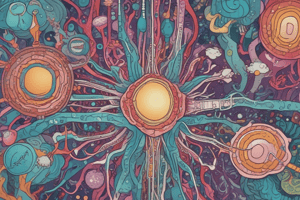Podcast
Questions and Answers
Which barbiturate is known for its long-acting effects?
Which barbiturate is known for its long-acting effects?
- Phenobarbital (correct)
- Pentobarbital
- Secobarbital
- Thiopental
Which of the following is an ultra-short-acting barbiturate, typically administered intravenously?
Which of the following is an ultra-short-acting barbiturate, typically administered intravenously?
- Phenobarbital
- Thiopental (correct)
- Amobarbital
- Secobarbital
Which receptor do barbiturates primarily affect in the central nervous system?
Which receptor do barbiturates primarily affect in the central nervous system?
- Dopamine receptor
- Opioid receptor
- Serotonin receptor
- GABA-A receptor (correct)
What is the primary effect of barbiturates on chloride channels?
What is the primary effect of barbiturates on chloride channels?
At high doses, what unique action can barbiturates exert on GABA-A receptors?
At high doses, what unique action can barbiturates exert on GABA-A receptors?
What is one of the secondary actions of barbiturates in the brain?
What is one of the secondary actions of barbiturates in the brain?
What effect do barbiturates have on the reticular activating system (RAS)?
What effect do barbiturates have on the reticular activating system (RAS)?
Which of the following best describes the CNS effect spectrum of barbiturates as the dosage increases?
Which of the following best describes the CNS effect spectrum of barbiturates as the dosage increases?
Which of the following conditions is phenobarbital still commonly used for?
Which of the following conditions is phenobarbital still commonly used for?
Which barbiturate is sometimes used for the induction of anesthesia?
Which barbiturate is sometimes used for the induction of anesthesia?
What is a common side effect associated with barbiturate use?
What is a common side effect associated with barbiturate use?
What is a serious potential side effect of barbiturate overdose?
What is a serious potential side effect of barbiturate overdose?
What potentially life-threatening effect can occur during barbiturate withdrawal?
What potentially life-threatening effect can occur during barbiturate withdrawal?
In which condition should barbiturates be avoided or used with extreme caution?
In which condition should barbiturates be avoided or used with extreme caution?
What is the effect of barbiturates on other drugs due to their action as a CYP450 inducer?
What is the effect of barbiturates on other drugs due to their action as a CYP450 inducer?
What potentially dangerous effect can occur when barbiturates are combined with other CNS depressants?
What potentially dangerous effect can occur when barbiturates are combined with other CNS depressants?
What is a paradoxical side effect that may occur in elderly or children taking barbiturates?
What is a paradoxical side effect that may occur in elderly or children taking barbiturates?
What potentially dangerous effect can IV barbiturates like thiopental have on blood pressure and heart rate?
What potentially dangerous effect can IV barbiturates like thiopental have on blood pressure and heart rate?
What consideration is important when discontinuing barbiturates to prevent severe withdrawal symptoms?
What consideration is important when discontinuing barbiturates to prevent severe withdrawal symptoms?
What is a risk to the fetus or newborn if barbiturates are taken during pregnancy?
What is a risk to the fetus or newborn if barbiturates are taken during pregnancy?
Flashcards
Common Barbiturates
Common Barbiturates
Phenobarbital (long-acting), Pentobarbital and Secobarbital (short-acting), Thiopental (ultra-short-acting, IV), and Amobarbital.
Barbiturates: Mechanism of Action
Barbiturates: Mechanism of Action
Bind to GABA-A receptors, enhancing chloride channel opening duration, leading to hyperpolarization and neuronal inhibition. High doses can directly activate GABA-A receptors.
Barbiturates: Clinical Uses
Barbiturates: Clinical Uses
Seizure disorders, sedation and anesthesia, insomnia (historically), euthanasia/lethal injection, status epilepticus, and neonatal seizures.
Barbiturates: Common Side Effects
Barbiturates: Common Side Effects
Signup and view all the flashcards
Barbiturates: Contraindications
Barbiturates: Contraindications
Signup and view all the flashcards
Barbiturates: Drug Interactions
Barbiturates: Drug Interactions
Signup and view all the flashcards
Barbiturates: Primary Action
Barbiturates: Primary Action
Signup and view all the flashcards
Barbiturates: CNS Effects
Barbiturates: CNS Effects
Signup and view all the flashcards
Barbiturates: Withdrawal symptoms
Barbiturates: Withdrawal symptoms
Signup and view all the flashcards
Study Notes
- Barbiturates are a class of drugs with various uses, but have a narrow safety profile.
Names of the Drugs & Mnemonics
- Phenobarbital is a long-acting barbiturate.
- Pentobarbital and Secobarbital are short-acting barbiturates.
- Thiopental is an ultra-short-acting barbiturate, administered intravenously.
- Amobarbital is also a common barbiturate.
- Mnemonic: "Barb’s PAST is Short and Long" (Phenobarbital, Amobarbital, Secobarbital, Thiopental).
- Alternative mnemonic: "The Short, Sexy Past of Phenomenal Barb" (Thiopental, Secobarbital, Pentobarbital, Phenobarbital, Barbiturates).
Mechanism of Action
- Barbiturates bind to the GABA-A receptor at a different site than benzodiazepines.
- They act as positive allosteric modulators of GABA-A receptors.
- Barbiturates, at low doeses enhance the duration of chloride (Cl⁻) channel opening when GABA is bound, leading to hyperpolarization and neuronal inhibition.
- At high doses, barbiturates mimic the effects of GABA-A receptor, even without GABA, increasing overdose risk.
- At even higher doses they can inhibit electron transport chain, causing cell death
- They also induce the metabolism of: Benzodiazepines, phenytoin, quinidine, warfarin. higher doses of these drugs may have to be given to reach desired effect
- Barbiturates suppress excitatory neurotransmission by inhibiting AMPA (glutamate) receptors.
- They depress the reticular activating system (RAS), causing sedation and hypnosis.
- CNS effects range from anxiolytic to sedative, hypnotic, anesthetic, coma, and death, depending on the dose.
Indications
- Clinical uses of barbiturates are now limited due to their safety profile.
- They are used for seizure disorders, especially phenobarbital.
- Thiopental is used for sedation and anesthesia induction.
- Historically used for insomnia, but now rare.
- Used in euthanasia and lethal injections.
- Phenobarbital can be used as a backup for status epilepticus.
- Phenobarbital is a first-line treatment for neonatal seizures.
- Acute anxiety states
Side Effects
- Common side effects include drowsiness and sedation.
- Other common side effects are dizziness and impaired concentration.
- Cognitive dulling is a common side effect.
- Tolerance and dependence can occur.
- Respiratory depression is a serious side effect.
- Overdoses can cause severe CNS depression, coma, and death.
- Risk of respiratory depression is higher when combined with alcohol, opioids, or benzodiazepines.
- Paradoxical excitement may occur, especially in the elderly or children.
- IV forms like thiopental can cause hypotension and bradycardia.
- Withdrawal symptoms include seizures and tremors.
- Anxiety and delirium can occur during withdrawal.
- Withdrawal can be life-threatening and requires slow tapering.
Contraindications
- Avoid or use with extreme caution in patients with porphyria, as it can precipitate acute attacks.
- Contraindicated in patients with respiratory disorders like COPD or sleep apnea.
- Avoid in individuals with a history of substance use disorder.
- Use cautiously in patients with liver dysfunction, as it affects metabolism.
- Contraindicated in pregnancy due to teratogenic effects and neonatal withdrawal.
- Barbiturates induce CYP450, decreasing levels of many drugs like warfarin, oral contraceptives, and antiepileptics.
- They potentiate other CNS depressants like opioids, alcohol, and BZDs.
Studying That Suits You
Use AI to generate personalized quizzes and flashcards to suit your learning preferences.



